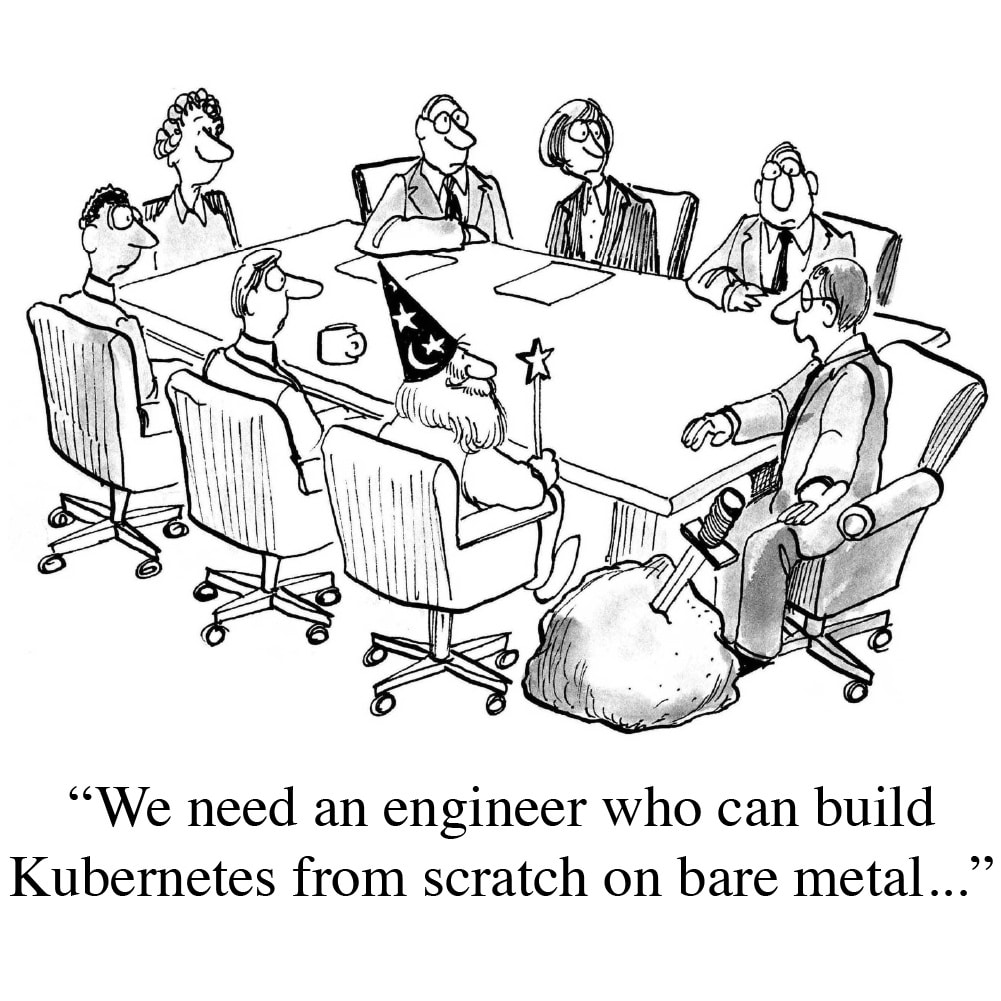Why the Best SREs Are Not Applying to Your Job Posting

Power Up Your Hiring Process from Job Description to Offer
SREs: An important cog in high-tech businesses. They are the missing link between development and operations. The staff who square the circle of the desire to develop new blockbuster features and the need to make sure those features don’t break what is there already. Sounds like DevOps, but it’s not.
If you’re unable to attract the best SREs to your vacancies, it’s time to unravel the confusion between hiring for DevOps engineers and hiring for Site Reliability Engineers (SREs). Then you can work on what is holding back your SRE talent recruitment.
SREs Are Pretty Unique
SREs are developers who really understand operations. They do the work of an operations expert but from the perspective of their expertise as software engineers. They interact with product teams, development teams, users, and a range of other stakeholders. Because they straddle ops and development in a unique way, they remove traditional conflicts between the functions. An SRE team may be responsible for:
- Availability
- Performance
- Latency
- Change management
- Efficiency
- Monitoring
- Capacity planning
The competency and effectiveness of your SRE team relies on its people and the process. It’s a shared function with a development team, and so reduces the number of developers you need to hire – the battle for talented employees to fill roles in both development and operations is therefore eliminated.
A great SRE knows how to find, analyze, and fix problems. They are fluid, being able to move effortlessly between functions, though their main focus will be on coding and developing systems that improve performance and efficiency.
So, what is it you should be doing to encourage the best SREs to apply to your vacancies?
To answer this question, we spoke to Reginald Davis, Site Reliability Engineer at Elastic, and Mike Bidak, Senior Executive Recruiter here at Kofi Group.
What Makes a Job Posting Stand Out?
Your job post needs to grab a candidate’s attention. It needs to make them want to learn more about the opportunity. It’s got to excite a candidate and let them know that they are exactly the person you are searching for.
Mike says that the best job descriptions are those that outline what’s expected from the SRE in the first six months, including the required skills and the technologies used.
“This usually gives the engineer a clear idea if their definition of SRE matches yours, but also gives more context around whether or not they can actually do the job,” he says.
Mike also observes that, “The best descriptions look like they were written by the hiring manager.” He notes the important elements to include are:
- What the new hire will work on for the first six months
- The size of the team
- On-call responsibilities and on-call rotations
- Kubernetes experience? Managing k8s? Building k8s from scratch?
- What are the selling points about working on that team? (Besides free lunch)
Reginald says:
“A great thing to communicate to potential talent is what the state of their SRE program is and what they are looking for from someone who joins the team. Communicating accurate expectations preps an engineer on exactly where they can add value to a team if they choose to join.
“There’s nothing wrong with an SRE program having some ambiguity (makes sense considering how much of a new concept this is), but there is a problem with not communicating with your engineers how they’re expected to bring value.”
Are You Selling the Role?
To attract the best, you must sell your vacancy as the best. This means delivering what the most talented candidates are seeking from the outset. This process starts with a deep understanding of your requirements.
“Do you want a dedicated SRE that is skilled in one area (like a Linux automation expert), or are you looking for a Jack-of-all-trades who can set up infrastructure, automate it, and contribute towards product development with software engineering?” asks Mike. “Most startups assume that the best SRE that comes in has touched a bit of everything – and the usual expectation is they are the problem solvers.”
Mike also highlights why job descriptions can be so off-putting.
“Candidates usually want to understand why the company wants an SRE,” he says. “A lot of SREs get pitched roles where it’s to clean up someone else’s mess (decomposing monoliths to microservices, mending together infrastructure that looks like it’s held up with toothpicks and Gorilla glue).”
What the most talented candidates really want to know is how working for your company will help them in their career.
“Candidates will ask, does anyone else have actual SRE experience or do they really believe in implementing SRE principals into the organization?” Mike explains. “They want to know what projects they will be working on that will help them with their own career development. For example, implementing k8s from scratch is exciting because that’s a great thing to have on a resume.”
Negotiate the Hurdle of Interview Process
Mike has spoken to and placed dozens of SREs, and so knows a thing or two when it comes to what irks candidates about the interview process.
“Setting a coding challenge as a first step is a no-no. Most SREs won’t put up with this. They want to talk to a hiring manager to find out whether it’s a good idea or not to even interview further,” he says.
It’s also critical to get the hiring manager engaged in the interviewing process early.
“Often, a culture call with a recruiter is a first step, yet most of the time internal recruiters don’t have the technical chops to walk through the bits and pieces that would make an engineer excited about a role or not. That’s why a ‘first date call’ with a hiring manager or VP is really important,” explains Mike.
How you conduct the hiring and interview process is also key. “You’ll find that SREs equate their experiences with the interview process to how the internal team is run,” says Mike.
“I once had an engineer who experienced a manager missing a call twice. The candidate – who was a great fit for the role – pulled out, telling me, ‘If they can’t figure out how to do a phone call internally for a scheduled interview, imagine how hard it’s going to be for them to get cars to drive themselves, please remove me from their process’.”
Set Positive Expectations
Reginald says that hiring startups can do more to solidify a candidate’s enthusiasm for the role. You’ve attracted great candidates with a great job description. Early in the interview process is when you must build on this.
“Give talent the power to have an impact when they join the team. The best engineer is an invested one!” says Reginald. “This doesn’t mean let them sink or swim. It means setting expectations in the beginning, training them up to understand your environment, and once they’ve shown a solid understanding of your system, giving them the freedom to make things better.”
Speed Is the Essence of a Good Hiring Process for SREs
A slow interview process will undo all your hard work to date.
“SREs need to be flown through the interview process,” says Mike. “I can’t even go into how many times I’ve tried to place an SRE with one of my clients and they end up in final-round interviews with new companies before I get them into a first round with mine. You can’t sleep on these profiles.”
Rule number one is to move as if every one of your competitors has reached out to the candidate at the same time.
“The best SRE hiring managers that I have worked with are able to get this done in a matter of a week or less. Moving quickly in an interview process allows the candidate to feel like the team they are considering gets sh*t done,” Mike asserts.
When Designing Your Hiring Process, Step into a Candidate’s Shoes
If you really want to get your hiring process right and get the signature of top candidates, put yourself in the candidate’s shoes. Do unto them as you would like done unto you.
Imagine a candidate who has been encouraged to apply for two similar SRE roles by impeccably composed job descriptions. Here’s how each of these hiring companies approached the interview process:
Company A sends an availability request for this week:
- Their response is prompt, and an interview is scheduled for a time in the next five days.
- The interview runs smoothly, and they tell you in the interview that they’d like to move forward. They immediately get your availability.
- The final round is scheduled, and the offer decision is made within 24 hours of the interview.
Company B explains that the hiring manager has your resume, and they are waiting for feedback:
- They take a week to get back with available times slots that work for the hiring team.
- The actual interview doesn’t get scheduled until a week after that.
- Guess what? The candidate is gone because they found company A’s process much more encouraging.
Let’s finish with Mike’s description of the company he most enjoyed placing an SRE for.
“It has to be Tally, in San Francisco,” Mike says. “The hiring manager knew what he wanted, gave immediate feedback and had an extreme sense of urgency.
“I kept track of how many submittals turned to interviews. Almost every one of our 16 submittals were interviewed.
“The hiring manager had an open Slack channel with everyone involved in the hiring decision on it. This allowed him to delegate tasks to the appropriate parties when needed. For example, he’d tell the recruiter to get something scheduled and I could see that he did that.
“The interview process was transparent. Quick to schedule and not too lengthy.
“The outcome? Tally hired two SREs in less than 30 days, from 16 submittals and three offers made.”
Are you considering hiring for SREs? To benefit from the Kofi Group experience, get in touch with Kofi Group today.
Share This Blog
Kofi Group has helped 100+ startups hire software and machine learning engineers. Will fill most of the roles we recruit on with 5 or less candidates presented.
Contact us today to start building your dream team!


